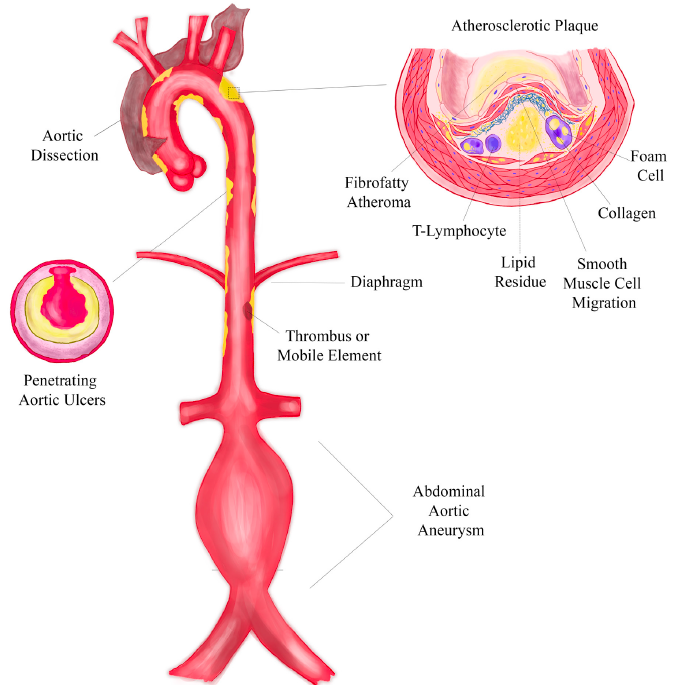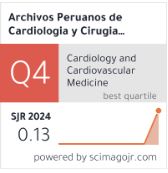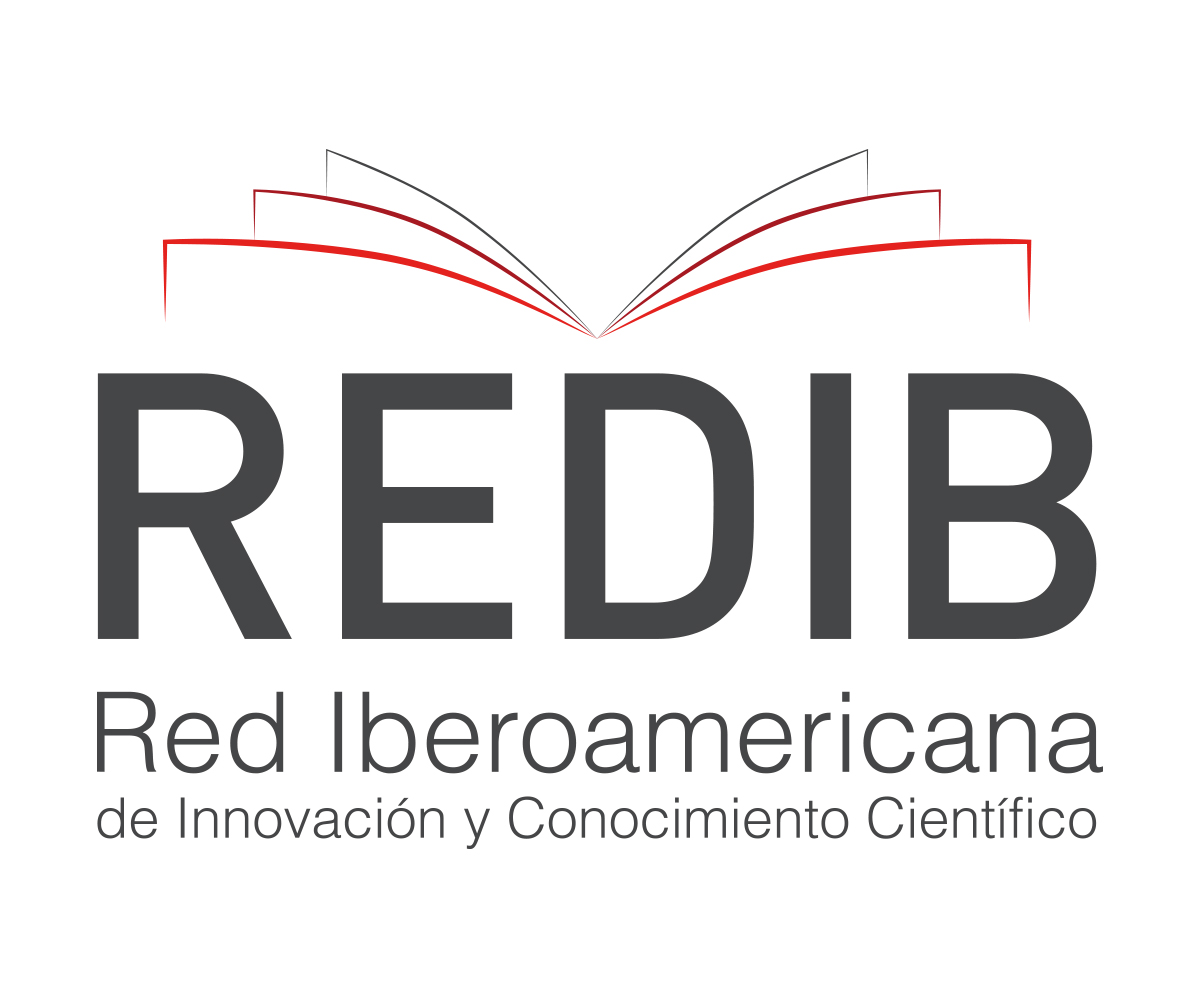Shaggy aorta: ideal substrate for disaster. Updated review
DOI:
https://doi.org/10.47487/apcyccv.v5i3.410Palabras clave:
Aorta, Atheroesclerosis, Pathology, Multimodal ImagingResumen
Shaggy aorta (SA) is characterized by a critical and extensive atheromatous disease of the thoracic and abdominal aorta. This degenerative and dangerous pathology is the result of the confluence of multiple modifiable and non-modifiable risk factors. The clinical importance of this pathology relies on the various syndromes that can develop from its etiopathogenesis, which generates great morbidity and mortality in the affected patients. In this document, we present an updated and detailed review of this entity, developing aspects of its pathophysiology, diagnosis, including the importance of multimodal imaging, and its therapeutic approach. Finally, we present the clinical settings of patients with SA in different aortic scenarios (aortic dissection, ulcerated plaques, and thrombosed aneurysms) that denote the nature of this disease and its high mortality.
Descargas
Referencias
Mitchell RN, Connolly AJ, Halushka MK. Blood vessels. In: Turner JR, editor. Robbins & Cotran Pathologic Basis of Disease, 10e. Barcelona: Elsevier; 2021. p. 485-508.
Illuminati G, Bresadola L, D’Urso A, Ceccanei G, Vietri F. Simultaneous stent grafting of the descending thoracic aorta and aortofemoral bypass for “shaggy aorta” syndrome. Can J Surg. 2007;50(5):E1-2.
Hollier LH, Kazmier FJ, Ochsner J, Bowen JC, Procter CD. “Shaggy” aorta syndrome with atheromatous embolization to visceral vessels. Ann Vasc Surg. 1991;5(5):439-444. doi:10.1007/BF02133048.
Braverman AC, Schermerhorn M. Diseases of the Aorta. In: Libby P, editor. Braunwald’s Heart Disease Review and Assessment 12e E-Book. Elsevier; 2022. p. 806-36.
Vaideeswar P, Zare P. Shaggy Aortic Syndrome, Penetrating Atherosclerotic Ulcer, and Rupture. In: Vaideeswar P, editor. Tropical Cardiovascular Pathology Autopsy-Based Clinicopathological Cases. Singapore: Springer; p. 319-21. doi: 10.1007/978-981-19-3720-0_58.
Lindblad B. Commentary on ‘Impact of Shaggy Aorta in Patients with Abdominal Aortic Aneurysm Following Open or Endovascular Aneurysm Repair’. Eur J Vasc Endovasc Surg. 2016;52(5):620. doi: 10.1016/j.ejvs.2016.09.003.
Kwon H, Han Y, Noh M, Gwon JG, Cho YP, Kwon TW. Impact of Shaggy Aorta in Patients with Abdominal Aortic Aneurysm Following Open or Endovascular Aneurysm Repair. Eur J Vasc Endovasc Surg. 2016;52(5):613-619. doi: 10.1016/j.ejvs.2016.08.010.
Okada K, Omura A, Kano H, Inoue T, Oka T, Minami H, et al. Effect of atherothrombotic aorta on outcomes of total aortic arch replacement. J Thorac Cardiovasc Surg 2013;145:984-991. doi: 10.1016/j.jtcvs.2012.03.048.
Nielsen LAG, Padilla G, Feldman R, Barbaglia C. Aorta SHAGGY. Patología aún vigente. Revista de la Federación Argentina de Cardiología. 2021;50:16-19.
Castro Luna BD. Prevalencia y características de pacientes con diagnóstico de Aorta Peluda por Angiotomografía en los últimos
años en Hospital Especialidades CMN La Raza [Tesis]. Facultad de Medicina, Universidad Nacional Autónoma de México; 2023.
Talledo O, Valdez LM, Torres L, De la Peña O, Calle A. Enfermedad oclusiva aorto-iliaca: Del tratamiento quirúrgico al endovascular. Rev Med Hered. 2015;26(3):177-185.
Lusis AJ. Atherosclerosis. Nature. 2000;407(6801):233-241. doi: 10.1038/35025203.
Soehnlein O, Libby P. Targeting inflammation in atherosclerosis - from experimental insights to the clinic. Nat Rev Drug Discov. 2021;20(8):589-610. doi: 10.1038/s41573-021-00198-1.
Wojtasińska A, Frąk W, Lisińska W, Sapeda N, Młynarska E, Rysz J, et al. Novel Insights into the Molecular Mechanisms of Atherosclerosis. Int J Mol Sci. 2023;24(17):13434. doi: 10.3390/ijms241713434.
Wigner P, Dziedzic A, Synowiec E, Miller E, Bijak M, Saluk-Bijak J. Variation of genes encoding nitric oxide synthases and antioxidant enzymes as potential risks of multiple sclerosis development: a preliminary study. Sci Rep. 2022;12(1):10603. doi: 10.1038/s41598- 022-14795-6.
Miao L, St Clair DK. Regulation of superoxide dismutase genes: implications in disease. Free Radic Biol Med. 2009;47(4):344-56. doi: 10.1016/j.freeradbiomed.2009.05.018.
Kang DH, Kang SW. Targeting cellular antioxidant enzymes for treating atherosclerotic vascular disease. Biomol Ther (Seoul). 2013;21(2):89-96. doi: 10.4062/biomolther.2013.015.
Niu N, Xu S, Xu Y, Little PJ, Jin ZG. Targeting Mechanosensitive Transcription Factors in Atherosclerosis. Trends Pharmacol Sci. 2019;40(4):253-266. doi: 10.1016/j.tips.2019.02.004.
Komatsu S, Takahashi S, Toyama Y, Kodama K. Exploring inside a shaggy aorta using non-obstructive angioscopy. BMJ Case Rep. 2017;2017:bcr2017219449. doi: 10.1136/bcr-2017-219449.
Gusev E, Sarapultsev A. Atherosclerosis and Inflammation: Insights from the Theory of General Pathological Processes. Int J Mol Sci. 2023;24(9):7910. doi: 10.3390/ijms24097910.
Lim S, Park S. Role of vascular smooth muscle cell in the inflammation of atherosclerosis. BMB Rep. 2014;47(1):1-7. doi: 10.5483/ bmbrep.2014.47.1.285.
Popa-Fotea NM, Ferdoschi CE, Micheu MM. Molecular and cellular mechanisms of inflammation in atherosclerosis. Front Cardiovasc Med. 2023;10:1200341. doi: 10.3389/fcvm.2023.1200341.
Martinet W, Schrijvers DM, De Meyer GR. Necrotic cell death in atherosclerosis. Basic Res Cardiol. 2011;106(5):749-60. doi: 10.1007/ s00395-011-0192-x.
Tanaka H, Zaima N, Sasaki T, Hayasaka T, Goto-Inoue N, Onoue K, et al. Adventitial vasa vasorum arteriosclerosis in abdominal aortic aneurysm. PLoS One. 2013;8(2):e57398. doi: 10.1371/journal. pone.0057398.
Uimonen M. Synthesis of multidimensional pathophysiological process leading to type A aortic dissection: a narrative review. J Thorac Dis. 2021;13(10):6026-6036. doi: 10.21037/jtd-21-829.
Milutinović A, Šuput D, Zorc-Pleskovič R. Pathogenesis of atherosclerosis in the tunica intima, media, and adventitia of coronary arteries: An updated review. Bosn J Basic Med Sci. 2020;20(1):21-30. doi: 10.17305/bjbms.
Kockx MM, Herman AG. Apoptosis in atherosclerosis: beneficial or detrimental? Cardiovasc Res. 2000;45(3):736-46. doi: 10.1016/s0008- 6363(99)00235-7.
Baaten CCFMJ, Nagy M, Bergmeier W, Spronk HMH, van der Meijden PEJ. Platelet biology and function: plaque erosion vs. rupture. Eur Heart J. 2024;45(1):18-31. doi: 10.1093/eurheartj/ehad720.
Finn AV, Nakano M, Narula J, Kolodgie FD, Virmani R. Concept of vulnerable/unstable plaque. Arterioscler Thromb Vasc Biol. 2010;30(7):1282-92. doi: 10.1161/ATVBAHA.108.179739.
Serra R, Bracale UM, Jiritano F, Ielapi N, Licastro N, Provenzano M, et al. The Shaggy Aorta Syndrome: An Updated Review. Ann Vasc Surg. 2021;70:528-541. doi: 10.1016/j.avsg.2020.08.009.
Ozkok A. Cholesterol-embolization syndrome: current perspectives. Vasc Health Risk Manag. 2019;15:209-220. doi: 10.2147/VHRM. S175150.
Ghanem F, Vodnala D, Kalavakunta J, Durga S, Thormeier N, Subramaniyam P, et al. Cholesterol crystal embolization following plaque rupture: a systemic disease with unusual features. J Biomed Res. 2017;31(2):82-94. doi: 10.7555/JBR.31.20160100.
Saric M, Kronzon I. Cholesterol embolization syndrome. Curr Opin Cardiol. 2011;26(6):472-9. doi: 10.1097/HCO.0b013e32834b7fdd.
Kotsis T, Spyropoulos BG, Asaloumidis N, Christoforou P, Katseni K, Papaconstantinou I. Penetrating Atherosclerotic Ulcers of the Abdominal Aorta: A Case Report and Review of the Literature. Vasc Specialist Int. 2019;35(3):152-159. doi: 10.5758/vsi.2019.35.3.152.
Sorber R, Hicks CW. Diagnosis and Management of Acute Aortic Syndromes: Dissection, Penetrating Aortic Ulcer, and Intramural Hematoma. Curr Cardiol Rep. 2022;24(3):209-216. doi: 10.1007/ s11886-022-01642-3.
AhmadF,CheshireN,HamadyM.Acuteaorticsyndrome:pathology and therapeutic strategies. Postgrad Med J. 2006;82(967):305-12. doi: 10.1136/pgmj.2005.043083.
Banceu CM, Banceu DM, Kauvar DS, Popentiu A, Voth V, Liebrich M, et al. Acute Aortic Syndromes from Diagnosis to Treatment-A Comprehensive Review. J Clin Med. 2024;21;13(5):1231. doi: 10.3390/ jcm13051231.
Perone F, Guglielmo M, Coceani M, La Mura L, Dentamaro I, Sabatino J, et al. The Role of Multimodality Imaging Approach in Acute Aortic Syndromes: Diagnosis, Complications, and Clinical Management. Diagnostics (Basel). 2023;13(4):650. doi: 10.3390/diagnostics13040650.
Evangelista A, Sitges M, Jondeau G, Nijveldt R, Pepi M, Cuellar H, et al. Multimodality imaging in thoracic aortic diseases: a clinical consensus statement from the European Association of Cardiovascular Imaging and the European Society of Cardiology working group on aorta and peripheral vascular diseases. Eur Heart J Cardiovasc Imaging. 2023;24(5):e65-e85. doi: 10.1093/ehjci/jead024.
Paulraj S, Ashok Kumar P, Uprety A, Chaudhuri D. Aortic dissection and multimodality imaging. Echocardiography. 2020;37(9):1485- 1487. doi: 10.1111/echo.14820.
Akcay M, Camlıdag İ. Multimodality imaging of asymptomatic huge floating thrombus in the thoracic aorta. Anatol J Cardiol. 2020;24(1):E1. doi: 10.14744/AnatolJCardiol.2020.56581.
BhaveNM,NienaberCA,CloughRE,EagleKA.MultimodalityImaging of Thoracic Aortic Diseases in Adults. JACC Cardiovasc Imaging. 2018;11(6):902-919. doi: 10.1016/j.jcmg.2018.03.009.
Little CD, Mackle EC, Maneas E, Chong D, Nikitichev D, Constantinou J, et al. A patient-specific multi-modality abdominal aortic aneurysm imaging phantom. Int J Comput Assist Radiol Surg. 2022;17(9):1611- 1617. doi: 10.1007/s11548-022-02612-4.
Yoshioka K, Tanaka R. MRI and MRA of Aortic Disease. Ann Vasc Dis. 2010;3(3):196-201. doi: 10.3400/avd.sasdi10003.
EvangelistaA,GarotJ.Roleofmagneticresonanceimaginginaortic disease. Oxford: Oxford University Press eBooks; 2015. doi: 10.1093/ med/9780198703341.003.0044.
Dev R, Gitanjali K, Anshuman D. Demystifying penetrating atherosclerotic ulcer of aorta: unrealised tyrant of senile aortic changes. J Cardiovasc Thorac Res. 2021;13(1):1-14. doi: 10.34172/ jcvtr.2021.15.
Tanaka R, Yoshioka K, Abiko A. Updates on Computed Tomography Imaging in Aortic Aneurysms and Dissection. Ann Vasc Dis. 2020;13(1):23-27. doi: 10.3400/avd.ra.19-00127.
Guevara E, Bagnati, R, Bastianelli G, Baratta S, Battu C, Bluro I, et al. Consenso de Patología de la Aorta. Rev Argent Cardiol. 2023;91(Suplemento 1):1-97. doi: 10.7775/rac.es.v91.s1.
AliL,SafanA,KamranS,AkhtarN,ElalamyO.AcuteThromboembolic Ischemic Stroke From Complex Aortic Arch Plaque. Cureus. 2021;13(8):e16977. doi: 10.7759/cureus.16977.
Thenappan T, Ali Raza J, Movahed A. Aortic atheromas: current concepts and controversies-a review of the literature. Echocardiography. 2008;25(2):198-207. doi: 10.1111/j.1540- 8175.2007.00568.x.
Harloff A, Brendecke SM, Simon J, Assefa D, Wallis W, Helbing T, et al. 3D MRI provides improved visualization and detection of aortic arch plaques compared to transesophageal echocardiography. J Magn Reson Imaging. 2012;36(3):604-11. doi: 10.1002/jmri.23679.
Isselbacher EM, Preventza O, Hamilton Black J 3rd, Augoustides JG, Beck AW, Bolen MA, et al. Peer Review Committee Members. 2022 ACC/ AHA Guideline for the Diagnosis and Management of Aortic Disease: A Report of the American Heart Association/American College of Cardiology Joint Committee on Clinical Practice Guidelines. Circulation. 2022;146(24):e334-e482. doi: 10.1161/CIR.0000000000001106.
Meyermann K, Trani J, Caputo FJ, Lombardi JV. Descending thoracic aortic mural thrombus presentation and treatment strategies. J Vasc Surg. 2017;66(3):931-936. doi: 10.1016/j.jvs.2017.05.109.
Tunick PA, Nayar AC, Goodkin GM, Mirchandani S, Francescone S, Rosenzweig BP, et al. NYU Atheroma Group. Effect of treatment on the incidence of stroke and other emboli in 519 patients with severe thoracic aortic plaque. Am J Cardiol. 2002;90(12):1320-5. doi: 10.1016/s0002-9149(02)02870-9.
SternA,TunickPA,CullifordAT,LachmannJ,BaumannFG,Kanchuger MS, et al. Protruding aortic arch atheromas: risk of stroke during heart surgery with and without aortic arch endarterectomy. Am Heart J. 1999;138(4 Pt 1):746-52. doi: 10.1016/s0002-8703(99)70191-2.
Zidi M, Nallet O, Esteve JB, Michaud P, Cattan S. Dissection coronaire extensive compliquant une angioplastie: à propos d’une série de 19 cas consécutifs [Extensive iatrogenic coronary dissection during coronary angioplasty: a series of 19 consecutive patients]. Ann Cardiol Angeiol (Paris). 2010;59(5):306-10. French. doi: 10.1016/j. ancard.2010.08.012.

Publicado
Número
Sección
Licencia
Derechos de autor 2024 La revista es titular de la primera publicación, luego el autor dando crédito a la primera publicación.

Esta obra está bajo una licencia internacional Creative Commons Atribución 4.0.

















